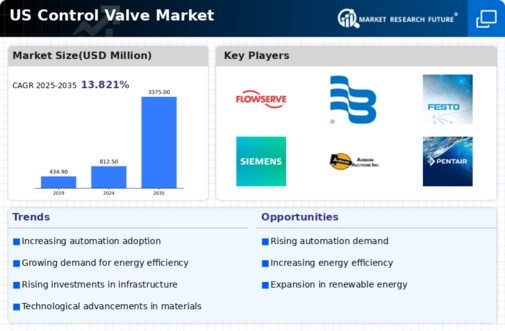Rising Demand in Oil and Gas Sector
The control valve market is experiencing a notable surge in demand, particularly within the oil and gas sector. This industry relies heavily on control valves for efficient operation and safety in various processes, including extraction, refining, and distribution. As of 2025, the oil and gas sector accounts for approximately 30% of the total market share in the control valve market. The increasing exploration activities and the need for enhanced operational efficiency are driving this demand. Furthermore, the shift towards more automated systems in oil and gas operations necessitates advanced control valves that can provide precise control and reliability. This trend indicates a robust growth trajectory for the control valve market, as companies invest in upgrading their infrastructure to meet modern operational standards.
Emerging Applications in Renewable Energy
The control valve market is witnessing growth due to emerging applications in the renewable energy sector. As the United States transitions towards cleaner energy sources, the demand for control valves in wind, solar, and bioenergy applications is increasing. By 2025, the renewable energy sector is projected to represent approximately 10% of the control valve market. This growth is driven by the need for efficient flow control in energy generation and distribution systems. Control valves play a crucial role in managing the flow of fluids and gases in renewable energy installations, ensuring optimal performance and reliability. As investments in renewable energy infrastructure continue to rise, the control valve market is likely to expand, reflecting the broader shift towards sustainable energy solutions.
Growth in Water and Wastewater Management
The control valve market is significantly influenced by the growing focus on water and wastewater management in the United States. With increasing concerns over water scarcity and environmental sustainability, municipalities and industries are investing in advanced control systems to optimize water usage and treatment processes. As of 2025, the water and wastewater management sector represents around 25% of the control valve market. This growth is driven by the need for efficient flow control, pressure regulation, and system reliability in treatment plants. Moreover, regulatory pressures to improve water quality and reduce waste are prompting investments in modern control valve technologies. Consequently, the control valve market is poised for expansion as stakeholders prioritize sustainable practices and infrastructure improvements.
Regulatory Compliance and Safety Standards
The control valve market is significantly shaped by the increasing emphasis on regulatory compliance and safety standards across various industries. In sectors such as pharmaceuticals, food and beverage, and chemicals, stringent regulations mandate the use of reliable control systems to ensure product quality and safety. As of 2025, compliance-related investments account for nearly 15% of the control valve market. Companies are compelled to adopt advanced control valve technologies that meet these regulatory requirements, thereby driving market growth. Additionally, the focus on safety in industrial operations necessitates the use of high-performance control valves that can withstand extreme conditions and prevent failures. This regulatory landscape suggests a sustained demand for control valves that adhere to safety and quality standards.
Industrial Automation and Smart Manufacturing
The control valve market is being propelled by the rapid advancement of industrial automation and smart manufacturing practices. As industries increasingly adopt automation technologies, the demand for sophisticated control valves that can integrate seamlessly with automated systems is rising. In 2025, it is estimated that the automation sector contributes approximately 20% to the control valve market. This trend is characterized by the implementation of Internet of Things (IoT) devices and advanced control systems that enhance operational efficiency and data analytics capabilities. The integration of smart control valves allows for real-time monitoring and adjustments, leading to improved process control and reduced operational costs. As manufacturers seek to optimize their production processes, the control valve market is likely to benefit from this shift towards automation.
























Leave a Comment